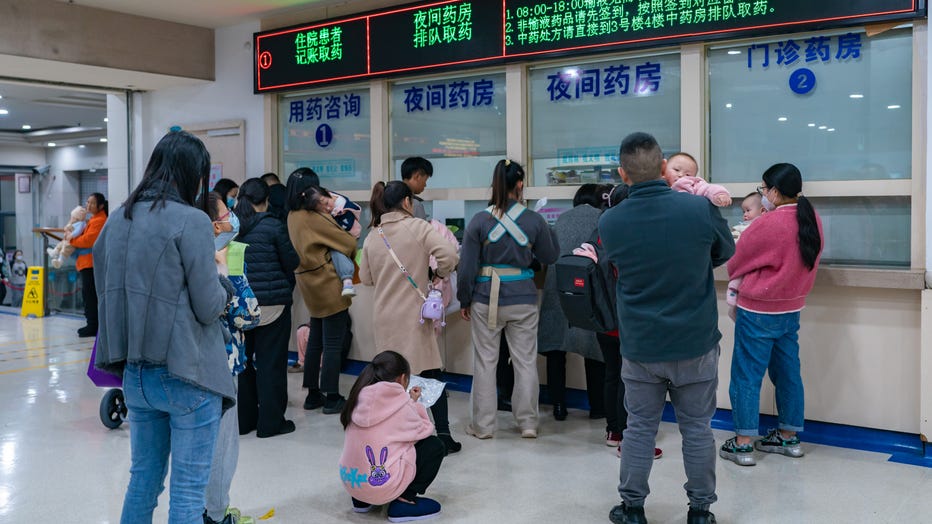Child pneumonia outbreak, dubbed 'white lung syndrome,' not a new virus, CDC says

What is respiratory syncytial virus (RSV)?
RSV is a common respiratory virus that usually causes mild, cold-like symptoms.
Pediatric pneumonia outbreaks in Ohio and Massachusetts are not linked to respiratory illness upticks in China or elsewhere – and they’re not the result of a novel virus, health officials stressed this week.
The Warren County Health District outside of Cincinnati, Ohio, has reported 145 cases of childhood pneumonia since August, but the outbreak is attributed to a large uptick in seasonal respiratory viruses – COVID-19, flu, RSV and Mycoplasma pneumoniae – not a novel virus.
"There has been zero evidence of this outbreak being connected to other outbreaks, either statewide, nationally or internationally," the statement said.

Acute pneumonia, seen on a cross-section thoracic CT-scan. (Photo by: BSIP/Universal Images Group via Getty Images)
Dr. Mandy Cohen, head of the Centers for Disease Control and Prevention, agreed with the local health department when asked about it Thursday.
"What we do know as of, again, as of today is we do not believe this is a new or novel pathogen," she said. "We believe this is all existing, meaning COVID, flu, RSV, mycoplasma."
Why is it called ‘white lung syndrome’?
Dr. Sarah Park, medical director of medical affairs at Karius, a California biotech company, told Fox News Digital the term "white lung syndrome" refers to some pneumonia-infected chest scans that show "diffusely damaged lungs."
MORE: Flu cases on the rise, RSV infections may be peaking, US health officials say
Doctors have seen more cases of Mycoplasma pneumoniae – a type of bacteria that can cause several different types of lung infection – but the infections haven’t been more severe than in years past. Most children have recovered at home with antibiotics, health officials said. Pneumonia can be caused by a number of bacteria, including Streptococcus pneumoniae, adenovirus, RSV, COVID-19, influenza and Staphylococcus aureus.

ERs and doctor's offices are filled with children suffering from respiratory illness, but experts say it's not linked to anything abnormal (Photo by Christoph Soeder/picture alliance via Getty Images)
COVID-19 continues to cause the most hospitalizations and deaths among respiratory illnesses — about 15,000 hospitalizations and about 1,000 deaths every week, Cohen said.
"The information was shared so that individuals would be aware of illness in the community and take necessary steps to protect their health such as washing their hands, covering cough, staying home when ill and staying up to date on vaccines," health officials in Ohio said.
What’s happening in China?
A recent surge in respiratory illnesses across China drew the attention of the World Health Organization, but health officials say those outbreaks were also caused by the flu and other known pathogens and not by a novel virus, the country’s health ministry said Sunday.
The WHO formally requested that China provide information about the potentially worrying spike in respiratory illnesses and clusters of pneumonia in children, as mentioned by several media reports and a global infectious disease monitoring service.

Parents with children who are suffering from respiratory diseases are lining up at a children's hospital in Chongqing, China, on November 23, 2023. (Photo by Costfoto/NurPhoto via Getty Images)
The emergence of new flu strains or other viruses capable of triggering pandemics typically starts with undiagnosed clusters of respiratory illness. Both SARS and COVID-19 were first reported as unusual types of pneumonia.
MORE: US life expectancy soared in 2022, but remains below pre-COVID level
Chinese authorities earlier this month blamed the increase in respiratory diseases on the lifting of COVID-19 lockdown restrictions. Other countries also saw a jump in respiratory diseases such as RSV when pandemic restrictions ended.
Pneumonia symptoms and how to protect your children from respiratory viruses

Hospitals and doctor's offices are seeing a large uptick in childhood pneumonia (Photo by Christoph Soeder/picture alliance via Getty Images)
Once someone becomes infected with the Mycoplasma pneumoniae bacteria, symptoms usually appear after one to four weeks, the CDC says. The most common type of infection is tracheobronchitis, better known as a chest cold. Mycoplasma can also lead to a condition known as "walking pneumonia." Symptoms of a chest cold often include:
- Sore throat
- Fatigue
- Fever
- Headache
- Slowly worsening cough that can last for weeks or months
Children younger than 5 years old who get M. pneumoniae infection could have different, cold-like symptoms, the CDC says:
- Sneezing
- Stuffy or runny nose
- Sore throat
- Watery eyes
- Wheezing
- Vomiting or diarrhea
According to Cedars-Sinai, pneumonia symptoms in a child include:
- Cough that produces mucus
- Cough pain
- Vomiting or diarrhea
- Loss of appetite
- Tiredness (fatigue)
- Fever
- Chills
- Fast or hard breathing
- Headache
- Fussiness
The Associated Press contributed to this report.

